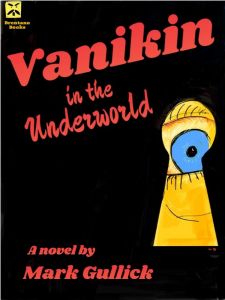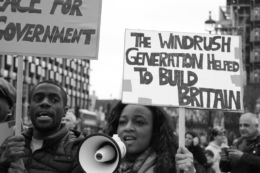A Different Black Pill
Posted By Mark Gullick On In North American New Right | Comments Disabled2,568 words
At the start of the millennium in the United Kingdom, an accusation of racism in the workplace might have led to a few cold shoulders in the office. Now, it is more likely you will be clearing out your desk, possibly with a police officer in attendance prior to your arrest. Slavishly following the United States, as always, “racism” has been weaponized and primed in Britain, a night-stick with which to beat whitey and an all-purpose get-out clause to explain and excuse black crime and failure. And, of course, all whites are racist. We are constantly reminded of this by blacks themselves (the new oligarchs), critical race theory (the new scriptures), and a compliant and timid media. So, all whites are racist, and I am white, so why fight a syllogism? I say: guilty as charged.
But was I born this way, or did my environment make me a racist? Blacks and their white liberal zookeepers get a little confused over this one. They are divided in the same way homosexuals are over the nature/nurture debate. Some gays are delighted with the idea they were born with “the gay gene,” others hysterically scream that this will lead to their being rounded up after some kind of genetic testing pogrom — neglecting to mention that this eventuality would be hugely more likely to take place in Tehran than Tennessee.
So, while some BLM and CRT cheerleaders see whiteness as original sin and racism as its main attribute present from birth, others see racism as the toxic residue of the process of white privilege. Where to begin? As always, at the beginning.
I was born in north London, England in 1961, although my family relocated to the suburbs when I was still a very young boy. Even in London in the ‘60s, a black face was a fairly rare sight outside of the Soho jazz clubs, where my mother saw many of the greats, and the suburbs were exclusively white.
There were Caribbeans in London, however, as 13 years before my birth there had been an influx of Jamaicans in circumstances which have been altered — just as happens in the United States — to fit the new and falsified version of “black history.”
In 1948, the ship Empire Windrush had docked at Tilbury in England with many hundreds of Jamaican passengers aboard. The firm line held by, for example, the world-famous British Broadcasting Corporation (BBC) is that these blacks were brought to England solely to work in jobs which did not appeal to the English. This is doubly false. Firstly, there were unlikely to be jobs that the post-war English — particularly in heavily-bombed London –would not do after the miserable war years. Secondly, the Jamaicans who arrived did so of their own volition, and not even the then government (Labour, and not Conservative, as the Black History website claims) knew about the voyage.
The Empire Windrush was in fact a troop ship chartered to bring home British soldiers from Australia, and someone had the bright idea of advertising a £28 (around $35) passage to England in a newspaper called The Daily Gleaner in Kingston, Jamaica, where the half-full ship was scheduled to dock en route. There were many takers. Although there was a recruitment drive in the late 1950s by London’s transport authority (I remember seeing many black bus drivers and ticket inspectors as a young boy on London’s famous red buses), the notion that the Windrush was some kind of latter-day slave ship and the journey to England a recreation of the Middle Passage is entirely false. But back to my smaller self in the London suburbs.
At my primary school (5-11 years) there were 120 children, all white. My grammar school (11-18 years, although I left aged 16) had 800 schoolboys, again none of whom were black, the most exotic students being a New Zealander, an Australian, and a Yugoslav. My sixth-form college (17-18 years) had a half-Malaysian girl as the one multicultural element among its several hundred students.
 [2]
[2]You can buy Mark Gullick’s Vanikin in the Underworld here. [3]
However, non-whites also lived in the suburbs, almost exclusively working for the National Health Service (NHS), mostly as nurses. Aged 16, I played cricket for a team at the local hospital for the mentally handicapped, eligible to turn out as my mother worked there as an art therapist. The team was like a “rest of the world” side, and I was one of just two white faces along with the Kiwi wicket-keeper. There was no malice either way — although plenty of good-humored badinage — and I remember enjoying the more loose-limbed, happy-go-lucky, casual attitude of the non-whites, who were mostly from India, Pakistan, the West Indies, and Africa. They grinned more than whites, and seemed to have a sense of fun and ease I had not seen in white suburbanites. And there was the clue. It would only be when I moved back into inner London that my attitude to non-whites — specifically Anglo-Caribbeans — began to change.
But that was in the late 1980s, after my first stint at university. Again, in 1981, my alma mater was almost completely white, with the exception of a specific school which was exclusively for non-white, mostly Commonwealth students on scholarships. Dressed as we were in our post-punk boots and jeans, we would occasionally see tall Namibians walking across campus in glorious and colorful national dress.
By the time I was reading for my PhD, I was back in London, my university having been Sussex, near Brighton on England’s south coast. I moved into the south London enclave of Brixton, a notoriously black area. I can honestly say that this made no difference to me, because I had yet to have the experiences which would open my eyes to the reality of living among inner-city blacks. All my degrees are in philosophy, and I began fully to appreciate exactly what empiricism means.
Brixton was not just black but, as I soon learned, anti-white — what we might call in keeping with modern trends “blancophobic.” I could feel a constant air of menace, and this was clearly occupied territory. By then, I was managing a restaurant bar in Covent Garden, and I was quite dressy, wearing suits, waistcoats, and brogue shoes. I quickly became aware of the malevolent looks and teeth-sucking from young black men I passed. It got worse.
Once a week, I would get a hot-towel shave from George the Greek, whose barber shop was opposite my block of flats. He would use an old-fashioned strop razor, and I would stay absolutely still as he often watched the horse-racing on his black-and-white TV while he shaved me. He never cut me, however, possibly because he was his father’s son. George once showed me how he was taught to shave a customer by his dad back in Greece, inflating a balloon, slathering it in shaving foam, and proceeding to remove all the lather with the strop razor, but without bursting the balloon.
One day, however, George had gone back to Greece on holiday, and I turned to a black-run barber. I walked in to malevolent and hostile stares and, when it came to my turn, I asked for a shave. I got the most memorable shave of my life. The barber shaved me dry.
I have seen it done in an old Hollywood movie, and I can tell you it hurts. But because I could tell that the clientele as well as the barber expected me to walk straight out with my tail between my legs, I did no such thing. I remember seeing the wide-eyed black faces in the mirror watching the white boy take it. When he was finished, I paid the barber and I tipped him, too.
I stayed in Brixton for four years before returning to my hometown in 1992. There were plenty of low-level incidents, but I learned which pubs were white, and which were no-go zones if you were. I took care to avoid the side-roads home from the underground after dark. Despite all this, there was still to be one more major incident.
In the large estate of apartments in which I lived, I was almost the only white man, and I often heard mutterings that I was a policeman. A few doors along was a black who owned a dog. Not many urban English blacks like dogs unless they are weaponized and can be used as a symbol of threat and aggression, and then they were either pit-bull Terriers or Rottweilers, and this was the latter. The dog would spend most of the day jumping up maniacally to look over the brick wall, barking furiously the whole time, and would only stop when exhausted. I saw it many times lying in the sun, panting with its tongue stuck to the concrete, no bowl of water laid out for it despite its owner sitting a couple of yards away in his kitchen smoking endless and pungent cannabis. I once called the famous British pet-rescue organization, the RSPCA (Royal Society for the Prevention of Cruelty to Animals), to report this blatant mistreatment. They have the legal power to intervene and remove animals from cruel or negligent owners, but when I told them where I lived, they told me they couldn’t do anything.
This powerful dog would always bark frantically at me or any other passerby on the way to the staircase. There was an elevator, but it was a mechanical urinal, and to get in as a white man was to show a death wish. One day, in a particularly foul mood, I told the dog to fuck off. On my return from the shops, it was loose and its owner waiting for me. He set the dog on me.
All I could do as it sprung at me was fend it off with my arm, which it bit into with its powerful jaws before the owner called it off, warning me not to even think about reporting the attack to the police. I remember the dog’s teeth scraping against the bone in my forearm. I still have a scar and, whenever I hear or read the word “racism” — on a daily if not hourly basis nowadays in the media — I look ruefully at the strip of white flesh.
Since then, even my hometown has become part of the urban black sprawl. Twenty years ago, I recall being in a nearby town which was at one time such a byword for suburban blandness that it featured as such in a Monty Python sketch. At the turn of the century, I saw a CPSO (Community Police Support Officer) surrounded by a group of black schoolchildren jeering and spitting at him at a bus stop. It reduced him to tears. The children were girls. My mother told me that several drivers on the local bus routes that took the black kids home had taken extended sick leave.
I moved back into London, taking a job which enabled me to live in areas in which any blacks either had decent jobs and so behaved themselves, or simply could not afford to be there except on “awayday” crime sprees. The rest of London, in the meantime, has become increasingly ghettoized. The last time I was in south London, I was alarmed at how blacks controlled the streets. A white man there now has to be very careful not to catch the eye of passing blacks, no matter how much they want this to happen. Now, knife crime — almost exclusively black-on-black — in the capital is at an all-time high and increasing. The Mayor of London, Sadiq Khan, is a Muslim and has absolutely no interest in reintroducing “stop and search,” the eminently sensible anti-crime procedure now deemed racist — and there is a reason for that. Anyone who lives in London and is honest knows that blacks and ordinary Muslims don’t exactly get on, despite the fact that many young Mohammedans ape the speech patterns and “dress sense” of their Anglo-Caribbean contemporaries. Most fatal stabbing victims are black, and for Khan, the only good black is a convert to Islam. As for prison, an ex-convict once told me that blacks ran the prison he was in.
The police are mostly powerless against black criminals, having been neutered in Britain just as they have been in America, but using a different method. Whereas the morale of the US police forces has been sapped by a combination of post-Floyd, BLM hysteria and the resultant calls for defunding, the British police have been made to jump through woke hoops. You are more likely to see the police in rainbow face-paint at a gay pride march than attending your burgled apartment. They are told to police tweets rather than streets.
The cost of black crime to any big city is not something the public would ever be allowed to see. The death rate from violent street crime would be far higher but for improvements in trauma medicine (the surgeons will almost certainly be mainly white, unthanked for saving “black bodies”), and the sheer amount of court time blacks take up must be incredibly expensive.
Nothing will change in London. The Mayor and his cronies will continue singling out racist statues and street names for removal while the butchery continues. Murders are often committed after a youth is chased by a gang of other youths and hacked to death. And yet they remain, in the parlance of the media, simply “youths.”
On New Year’s Day, GB News — supposedly a conservative alternative to the heavy Leftist bias of the BBC and other channels — had a seven-minute section on knife crime. The guest was a gentleman from an organization called the Ben Kinsella Trust, Ben Kinsella being a white boy who was stabbed to death by three blacks in 2008. The guest and the two hosts reeled through the usual platitudes without once mentioning the word “black” or alluding in any way to ethnicity. They talked about more funding, poor role models, the need to talk to parents, and COVID as a contributory cause. Even Breitbart News skirts round the issue. I always wonder whether these people feel a secret shame that they don’t talk about young blacks and the fact that they are the worst thing ever to happen to London or any British city, not just because of their own violent, narcissistic culture but also because of its influence on white and Muslim youth.
The US has a 13% black population, the UK a mere 3%. The trouble they cause, however, is entirely disproportionate, and now that they are empowered by a culture of worship the government has encouraged rather than questioned, this will only get worse. Britons are constantly told about the benefits of black culture, but it is hard to see what they are.
The government protects the image of black Britain just as it protects and promotes brand Islam despite Islamic terrorist attacks, grooming gangs, and a constant and unchallenged — and virally untested — influx of Muslim men entering England via the English Channel. In London, 90% of those held in custody under the age of 18 are black or Asian (in the British sense), and yet these figures are broadcast under the slippery title of “BAME,” or Black, Asian, Minority Ethnic. But you will have quite a task ahead of you if you wish to find a Sikh or a Chinaman in a British jail.
As for me, no, I wasn’t born a racist. I was made into one.
* * *
Counter-Currents has extended special privileges to those who donate $120 or more per year.
- First, donor comments will appear immediately instead of waiting in a moderation queue. (People who abuse this privilege will lose it.)
- Second, donors will have immediate access to all Counter-Currents posts. Non-donors will find that one post a day, five posts a week will be behind a “paywall” and will be available to the general public after 30 days.
To get full access to all content behind the paywall, sign up here:
Paywall Gift Subscriptions
 [4]If you are already behind the paywall and want to share the benefits, Counter-Currents also offers paywall gift subscriptions. We need just five things from you:
[4]If you are already behind the paywall and want to share the benefits, Counter-Currents also offers paywall gift subscriptions. We need just five things from you:
- your payment
- the recipient’s name
- the recipient’s email address
- your name
- your email address
To register, just fill out this form and we will walk you through the payment and registration process. There are a number of different payment options.
